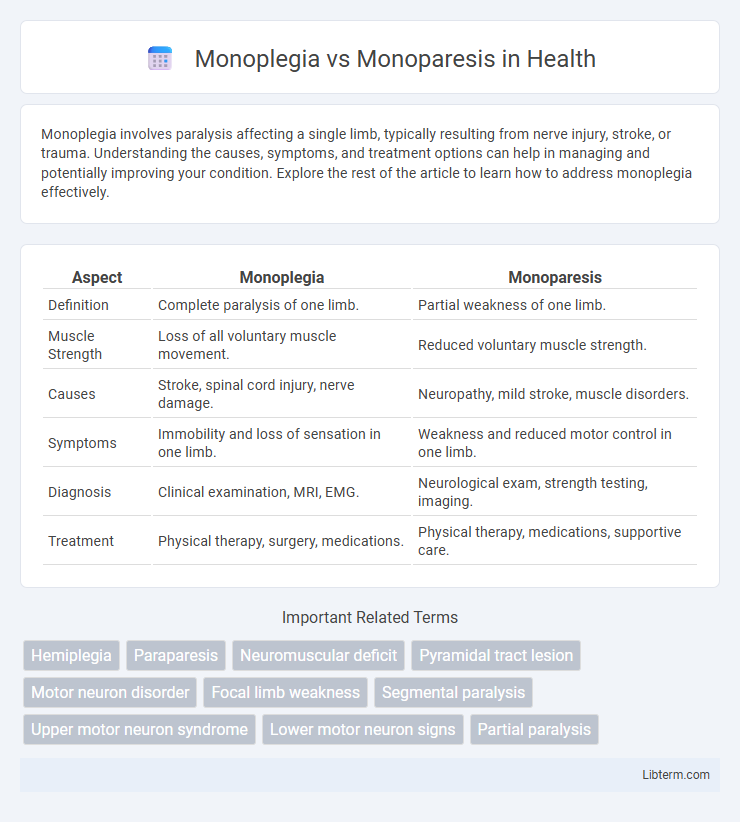Monoplegia involves paralysis affecting a single limb, typically resulting from nerve injury, stroke, or trauma. Understanding the causes, symptoms, and treatment options can help in managing and potentially improving your condition. Explore the rest of the article to learn how to address monoplegia effectively.
Table of Comparison
| Aspect | Monoplegia | Monoparesis |
|---|---|---|
| Definition | Complete paralysis of one limb. | Partial weakness of one limb. |
| Muscle Strength | Loss of all voluntary muscle movement. | Reduced voluntary muscle strength. |
| Causes | Stroke, spinal cord injury, nerve damage. | Neuropathy, mild stroke, muscle disorders. |
| Symptoms | Immobility and loss of sensation in one limb. | Weakness and reduced motor control in one limb. |
| Diagnosis | Clinical examination, MRI, EMG. | Neurological exam, strength testing, imaging. |
| Treatment | Physical therapy, surgery, medications. | Physical therapy, medications, supportive care. |
Definition of Monoplegia
Monoplegia is defined as the complete paralysis of a single limb, resulting in the total loss of motor function and voluntary movement in that specific area. It differs from monoparesis, which involves partial weakness or impaired muscle strength rather than full paralysis. Monoplegia commonly arises from neurological conditions such as stroke, brain injury, or nerve damage localized to the affected limb.
Definition of Monoparesis
Monoparesis is defined as a partial or incomplete weakness affecting a single limb, characterized by reduced muscle strength without complete paralysis. In contrast, monoplegia refers to total loss of motor function in one limb, resulting in complete paralysis. Understanding the distinction between monoparesis and monoplegia is critical for accurate neurological diagnosis and targeted rehabilitation strategies.
Key Differences Between Monoplegia and Monoparesis
Monoplegia refers to the complete paralysis of a single limb, resulting in total loss of voluntary muscle function, while monoparesis involves partial weakness or reduced muscle strength in one limb without full paralysis. Monoplegia is typically caused by severe neurological damage such as stroke or spinal cord injury, whereas monoparesis often arises from less severe nerve impairments or localized muscle disorders. The key difference lies in the degree of motor impairment: monoplegia exhibits no movement, whereas monoparesis retains some voluntary control and muscle activity.
Causes of Monoplegia
Monoplegia is characterized by the complete paralysis of a single limb, commonly resulting from brain or spinal cord injury, stroke, multiple sclerosis, or cerebral palsy. In contrast, monoparesis involves partial weakness rather than total paralysis, often caused by peripheral nerve damage, localized trauma, or neuropathies. Understanding the distinct causes of monoplegia aids in accurate diagnosis and targeted treatment for affected patients.
Causes of Monoparesis
Monoparesis, characterized by weakness in a single limb, often results from localized nerve injuries such as peripheral nerve trauma, compression neuropathies like carpal tunnel syndrome, or focal brain lesions including small strokes affecting the motor cortex. Unlike monoplegia, which involves complete paralysis, monoparesis reflects partial loss of muscle strength due to conditions like multiple sclerosis plaques, localized spinal cord lesions, or brachial plexus injury. Identifying the precise etiology of monoparesis requires thorough neurological examination and imaging studies to target treatment effectively.
Clinical Symptoms and Presentation
Monoplegia presents as complete paralysis of a single limb, characterized by total loss of motor function and absence of voluntary movement, often accompanied by muscle atrophy and sensory deficits. Monoparesis involves partial weakness or reduced strength in one limb, with preserved, though impaired, voluntary movement and less pronounced muscle wasting. Clinically, monoplegia results in more severe functional impairment compared to monoparesis, which may present with mild to moderate motor weakness and minimal sensory involvement.
Diagnosis: Monoplegia vs Monoparesis
Diagnosis of monoplegia versus monoparesis involves detailed neurological examination and electromyography (EMG) to assess muscle strength and nerve function in a single limb. Monoplegia is characterized by complete paralysis and loss of motor function, often confirmed through imaging studies like MRI to identify central nervous system lesions. In contrast, monoparesis presents as partial muscle weakness, with diagnostic emphasis on identifying peripheral nerve injury or localized muscle pathology through nerve conduction studies and clinical assessment.
Treatment Approaches
Monoplegia treatment often involves intensive physical therapy, occupational therapy, and sometimes surgical interventions to restore or maximize motor function in the affected limb. Monoparesis management usually emphasizes targeted physical rehabilitation and neurostimulation techniques to improve muscle strength and coordination while minimizing disability. Both conditions may benefit from assistive devices and multidisciplinary approaches tailored to the specific underlying cause and severity of impairment.
Rehabilitation and Recovery
Monoplegia involves complete paralysis of a single limb, often requiring intensive rehabilitation focused on restoring joint mobility, muscle strength, and functional use through physical therapy and assistive devices. Monoparesis, characterized by partial weakness rather than total paralysis, typically responds well to targeted strengthening exercises and neuromuscular re-education to improve coordination and motor control. Early intervention and personalized rehabilitation plans significantly enhance recovery outcomes for both monoplegia and monoparesis by preventing muscle atrophy and promoting neuroplasticity.
Prognosis and Long-Term Outcomes
Monoplegia involves complete paralysis of a single limb, typically resulting in a more severe functional deficit and longer rehabilitation time compared to monoparesis, which denotes partial weakness. Prognosis for monoplegia is generally poorer with a higher likelihood of persistent disability, while monoparesis often allows for significant recovery through physical therapy and neurorehabilitation. Long-term outcomes depend on the underlying cause, with ischemic or traumatic origins favoring better recovery in monoparesis due to preserved muscle function.
Monoplegia Infographic

 libterm.com
libterm.com